Bill D. (VA)
Silver Member
New site produces bonanza of 1600s artifacts plus early military buttons & much more
This has been a rough month on the personal side with the recent loss of my father-in-law, my son being in the hospital, and my car getting hit, and all 3 of those events happened with a 2 hour period on the 10th. But things are slowly getting back to normal, so I was finally able to find time to get out and roam the fields at a new, large site that was oozing with potential. I also invited my regular hunting buddies Dan, Joey, and Stan, and all came home with some nice keepers.
This property is loaded with house sites, many 19[SUP]th[/SUP] to early 20[SUP]th[/SUP] century, but a couple colonial hotspots were also discovered. One small spot tucked away in an unsuspecting corner was quite productive with most finds dating to the late 17[SUP]th[/SUP] to early 18[SUP]th[/SUP] centuries, and a large number of early buckles and leather ornaments were recovered there, but almost no buttons and absolutely zero coins. That was a huge disappointment as this spot had “cob” or “hammered” written all over it. It did not help that most of the area was covered with a very dense, tall clover thanks to the recent spell of warm weather, and this made it extremely difficult if not impossible to swing the coil close to the dirt. So I’m sure we left some nice ones in the ground, but we may never get a chance to recover them as the property will be under contract in the next few days and may become off limits forever.
In addition to the colonial goodies, I was able to stumble across 3 really nice military buttons in random locations while roaming around the fields. The best of these was a rare Hillsborough Military Academy (NC) button in great condition with its gilt almost totally intact and a stand-up shank. This button dates to 1859-60, and most of the cadets at this school joined the Confederate Army when the war started. The others included a War of 1812 era artillery button (“eagle on cannon”) plus an exquisite early navy button identified as Albert’s NA86A7. It includes the backmark “Wise, Bielby, Hyde & Co” plus No 1/Extra Fine, and was produced in Birmingham England around 1820-30. The gilt on this example is about as good as it gets for a dug button.
I did chase a deep iron signal in the middle of the 17[SUP]th[/SUP] century site and found not only a nice colonial hoe, but the base to a very early shaft and globe bottle, or at least from one of the transitional varieties which preceded the true onion forms. These are extremely hard to find and only at the very earliest sites. A second hoe with a long, narrow shape was also found nearby and is likely a 17[SUP]th[/SUP] century grubbing hoe, and it was fused to the bottom of the bottle base so they were obviously discarded at the same time. Early occupation of this site was also confirmed with the recovery a 4 clay pipe stems with a bore diameter of 7/64s” which generally equates to the 1650 to 1680 period. A wide assortment of finds spanning nearly 300 years were recovered at this interesting and diverse site, and many are shown in the collection of images below. I was obviously very pleased with the results of this hunt, but it was disappointing that I was unable to put a colonial coin of any type under my coil. But I know they’re hiding somewhere in that deep clover. Time for the ole plywood trick ....
This has been a rough month on the personal side with the recent loss of my father-in-law, my son being in the hospital, and my car getting hit, and all 3 of those events happened with a 2 hour period on the 10th. But things are slowly getting back to normal, so I was finally able to find time to get out and roam the fields at a new, large site that was oozing with potential. I also invited my regular hunting buddies Dan, Joey, and Stan, and all came home with some nice keepers.
This property is loaded with house sites, many 19[SUP]th[/SUP] to early 20[SUP]th[/SUP] century, but a couple colonial hotspots were also discovered. One small spot tucked away in an unsuspecting corner was quite productive with most finds dating to the late 17[SUP]th[/SUP] to early 18[SUP]th[/SUP] centuries, and a large number of early buckles and leather ornaments were recovered there, but almost no buttons and absolutely zero coins. That was a huge disappointment as this spot had “cob” or “hammered” written all over it. It did not help that most of the area was covered with a very dense, tall clover thanks to the recent spell of warm weather, and this made it extremely difficult if not impossible to swing the coil close to the dirt. So I’m sure we left some nice ones in the ground, but we may never get a chance to recover them as the property will be under contract in the next few days and may become off limits forever.
In addition to the colonial goodies, I was able to stumble across 3 really nice military buttons in random locations while roaming around the fields. The best of these was a rare Hillsborough Military Academy (NC) button in great condition with its gilt almost totally intact and a stand-up shank. This button dates to 1859-60, and most of the cadets at this school joined the Confederate Army when the war started. The others included a War of 1812 era artillery button (“eagle on cannon”) plus an exquisite early navy button identified as Albert’s NA86A7. It includes the backmark “Wise, Bielby, Hyde & Co” plus No 1/Extra Fine, and was produced in Birmingham England around 1820-30. The gilt on this example is about as good as it gets for a dug button.
I did chase a deep iron signal in the middle of the 17[SUP]th[/SUP] century site and found not only a nice colonial hoe, but the base to a very early shaft and globe bottle, or at least from one of the transitional varieties which preceded the true onion forms. These are extremely hard to find and only at the very earliest sites. A second hoe with a long, narrow shape was also found nearby and is likely a 17[SUP]th[/SUP] century grubbing hoe, and it was fused to the bottom of the bottle base so they were obviously discarded at the same time. Early occupation of this site was also confirmed with the recovery a 4 clay pipe stems with a bore diameter of 7/64s” which generally equates to the 1650 to 1680 period. A wide assortment of finds spanning nearly 300 years were recovered at this interesting and diverse site, and many are shown in the collection of images below. I was obviously very pleased with the results of this hunt, but it was disappointing that I was unable to put a colonial coin of any type under my coil. But I know they’re hiding somewhere in that deep clover. Time for the ole plywood trick ....
Attachments
-
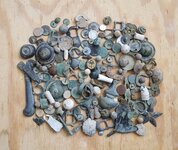 sykes all.jpg1.5 MB · Views: 280
sykes all.jpg1.5 MB · Views: 280 -
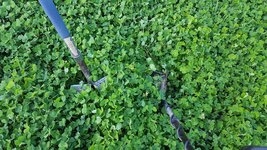 clover2.jpg478.9 KB · Views: 201
clover2.jpg478.9 KB · Views: 201 -
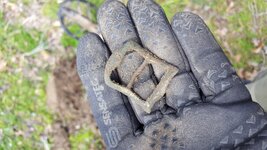 just dug buckle1.jpg333 KB · Views: 206
just dug buckle1.jpg333 KB · Views: 206 -
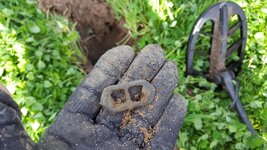 just dug buckle4.jpg302.9 KB · Views: 188
just dug buckle4.jpg302.9 KB · Views: 188 -
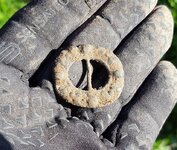 just dug buckle5.jpg229.4 KB · Views: 174
just dug buckle5.jpg229.4 KB · Views: 174 -
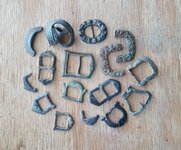 buckles1.jpg1,004 KB · Views: 212
buckles1.jpg1,004 KB · Views: 212 -
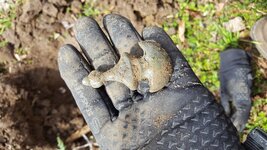 just dug ornament1.jpg336.9 KB · Views: 183
just dug ornament1.jpg336.9 KB · Views: 183 -
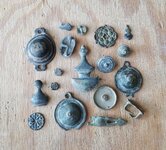 ornaments11.jpg921.1 KB · Views: 191
ornaments11.jpg921.1 KB · Views: 191 -
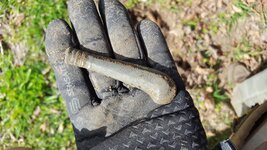 just dug knife handle.jpg345.3 KB · Views: 185
just dug knife handle.jpg345.3 KB · Views: 185 -
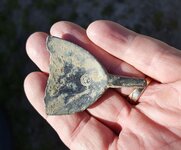 just dug latten spoon bowl.jpg573.3 KB · Views: 188
just dug latten spoon bowl.jpg573.3 KB · Views: 188 -
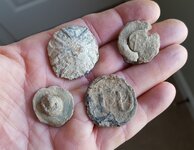 lead items1.jpg688.7 KB · Views: 190
lead items1.jpg688.7 KB · Views: 190 -
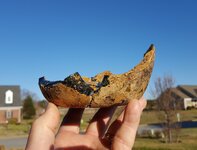 shaft and globe3.jpg432.5 KB · Views: 182
shaft and globe3.jpg432.5 KB · Views: 182 -
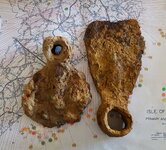 hoes1.jpg673.8 KB · Views: 171
hoes1.jpg673.8 KB · Views: 171 -
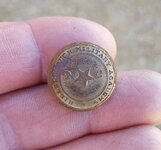 HMA button.jpg572.1 KB · Views: 182
HMA button.jpg572.1 KB · Views: 182 -
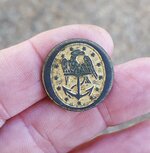 navy btn1.jpg668.8 KB · Views: 187
navy btn1.jpg668.8 KB · Views: 187 -
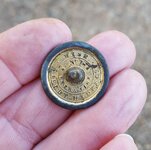 navy btn2.jpg643.5 KB · Views: 175
navy btn2.jpg643.5 KB · Views: 175 -
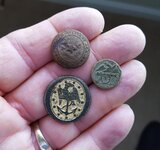 3 buttons.jpg645.5 KB · Views: 175
3 buttons.jpg645.5 KB · Views: 175 -
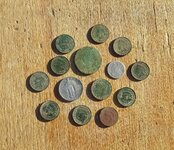 coins1.jpg593.1 KB · Views: 216
coins1.jpg593.1 KB · Views: 216 -
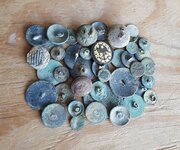 buttons all.jpg820.5 KB · Views: 174
buttons all.jpg820.5 KB · Views: 174 -
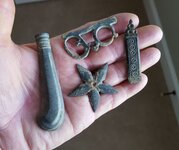 misc1.jpg546.2 KB · Views: 194
misc1.jpg546.2 KB · Views: 194
Upvote
64



 . I don't even know where to begin... As incredible as the marked spoon bowl and early military buttons are, I am really liking those two COMPLETE early hoe blades. They're going to look amazing. It's really cool the one was fused to the shaft and globe base. If you end up processing them soon, I'd love to see some pictures when they're done. Excellent hunt and post Bill and looking forward to the next one man.
. I don't even know where to begin... As incredible as the marked spoon bowl and early military buttons are, I am really liking those two COMPLETE early hoe blades. They're going to look amazing. It's really cool the one was fused to the shaft and globe base. If you end up processing them soon, I'd love to see some pictures when they're done. Excellent hunt and post Bill and looking forward to the next one man.


